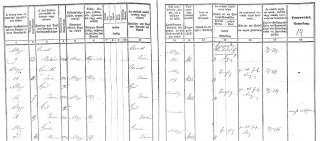of recruits born in 1845-46.
At various times, men were recruited for the army using a variety of methods. In some cases, they were simply "dragooned" -- captured and hauled off. At other times (especially in the years immediately after the 1848-49 War for Independence) induction was used as a punishment for rebel troops and sympathizers. At other times men at about 21 years of age were chosen by lot -- that seems to be the case with this 1867 muster roll. This latter form of "draft" was more typical during most of the period of the Austro-Hungarian Empire (1867-1918). Of course, there were always men who for a variety of reasons voluntarily joined the army. See the note below for further information about military service in Hungary during the Dual Monarchy period.
Format: Varies greatly with period.
This muster roll has 18-columns on two pages for each entry.





Content of this 1867 Army Muster Roll.
In general, muster rolls are not a likely source of good family history information. But, if all else fails, and you get lucky, you may find some useful information in them. This page is extracted from a muster roll for the village of Algyö, just outside the city of Szeged. Muster rolls are sometimes identified by the birthyear of the recruits, rather than the year they were prepared. So be careful to make sure you've got the right date.
The instructions in this muster roll are bilingual in Magyar and German, but the data recorded is in the Magyar language. It consists of 18 columns, many of which are self-explanatory. The columns are defined below:
- Town and catalog number -- I don't know the significance of the number.
- Lot number -- this is the "lottery" number that got him drafted.
- Family and given names of the recruit.
- Birthyear.
- Birthplace.
- Religion and Marital Status -- All here are RK (Roman Catholic) and nötlen (bachelors).
- Can he read? -- this and the next three questions were not answered for these recruits.
- Can he write?
- Can he play music? (were they looking for military band members?)
- Does he have a trade or profession?
- Family and given name of the father of the recruit.
- Town and house number where the recruit lives -- note that the whereabouts of the 4th person down are unknown (ismeretlen).
- Body size (ie. height) of the recruit in inches(!).
- Place of last employment -- not used here.
- Findings of the Recruitment Commission -- there are places for a "civil" and "military" commission, but they are not used, so I don't know the distinction. The information is illegible to me, but it's interesting to see that the three recruits with a simple answer here were the three who expressed wishes for assignment. Perhaps they were going more voluntarily than the first man.
- Wishes of the recruit concerning assignment -- three of the four recruits seemed to express wishes, two of them apparently to serve together.
- Date of conscription and military unit -- only the dates (all 30 Apr 1867) are recorded here. That may imply they were all being recruited for service in the local militia, but I'm not sure.
- Remarks -- not used here except for the recruit who apparently "flew the coop."
